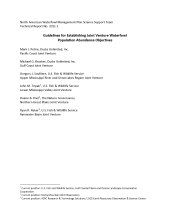
ABSTRACT
Joint Venture (JV) scientists use regional population abundance objectives for waterfowl to quantify habitat objectives and frame conservation delivery strategies. Inconsistent or unreliable approaches for deriving population objectives among JVs will, by extension, produce inconsistent or unreliable habitat objectives across JVs. Furthermore, a 2007 North American Waterfowl Management Plan (NAWMP) Continental Progress Assessment identified several JVs whose waterfowl population abundance objectives lacked a clear relationship to NAWMP continental goals, reenforcing a need for guidelines to establish population objectives at the JV regional scale. Consequently, a NAWMP Science Support Team (NSST) Committee was formed to review existing approaches and provide recommendations to formulate regional waterfowl population abundance objectives explicitly and consistently linked to NAWMP continental population goals. This effort included a workshop in February 2009 to facilitate review of existing approaches and to seek input from the NAWMP community on recommendations for improvement. Methods for establishing population abundance objectives and their use in JV conservation planning logically differ among periods of the waterfowl annual cycle (i.e., breeding, wintering, and migration). However, our workshop revealed even among JV regions focused on the same annual cycle period, establishment of population objectives varied and were often not linked to NAWMP goals. For example, the primary breeding regions in North America, encompassing the Prairie Habitat Joint Venture (PHJV) in Canada and the Prairie Pothole Joint Venture (PPJV) in the U.S., used different reference years for population objective setting. The PHJV retained NAWMP’s original reference period (i.e., based on 1970s abundances) whereas the PPJV revised their population objectives upward based on duck abundances during a recent time period (1994‐2004). Although no longer explicitly linked to current NAWMP population goals, the PPJV (and other breeding JVs) justified establishment of higher population objectives to reflect long‐term increases in breeding duck carrying capacity. JV waterfowl population abundance objectives for wintering and migration regions were generated using various combinations of population and harvest data, research on marked birds, and often expert opinion. Although none of the techniques we assessed for apportioning continental goals to wintering and migration regions were considered ideal, superior approaches were identified and recommendations for consistency were developed. Underlying discussions of change in landscape carrying capacity for breeding ducks and the importance of viable non‐breeding period distribution surveys was the explicit need to better coordinate among JVs. Using information we provide, the NAWMP community can move toward a more uniform and integrated approach for establishing regional population abundance objectives and ultimately more effective waterfowl habitat conservation at the continental scale.
